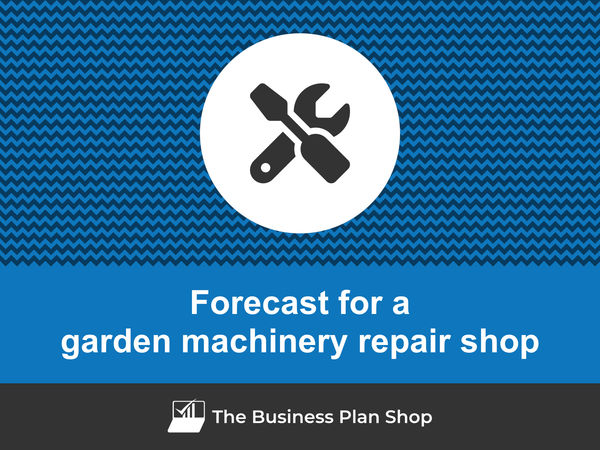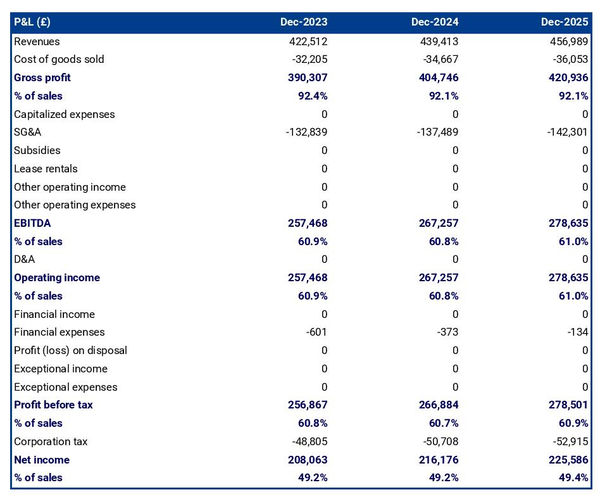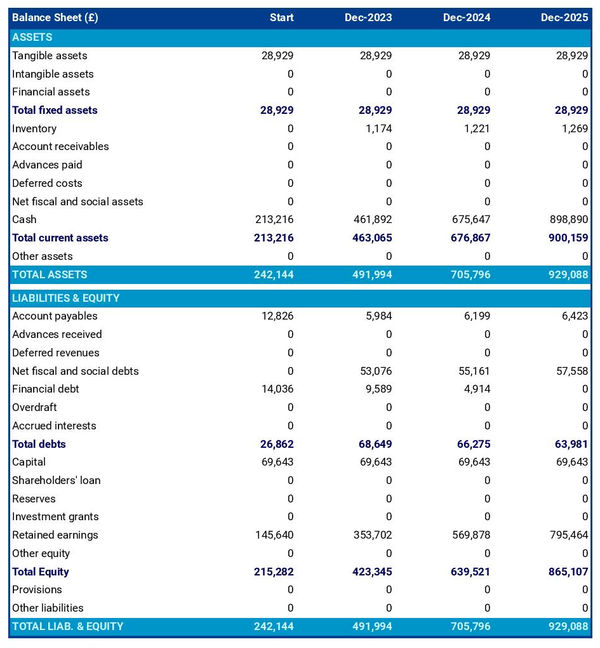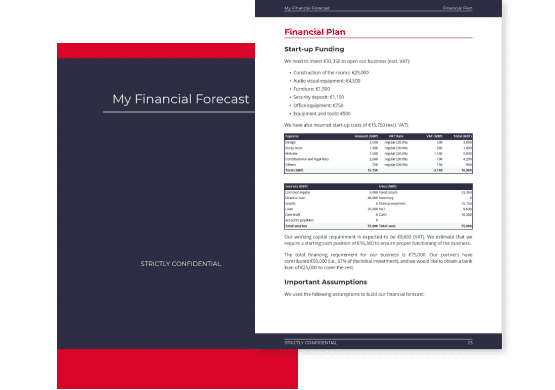How to create a financial forecast for a garden machinery repair shop?

Creating a financial forecast for your garden machinery repair shop, and ensuring it stays up to date, is the only way to maintain visibility on future cash flows.
This might sound complex, but with the right guidance and tools, creating an accurate financial forecast for your garden machinery repair shop is not that hard.
In this guide, we'll cover everything from the main goal of a financial projection, the data you need as input, to the tables that compose it, and the tools that can help you build a forecast efficiently.
Without further ado, let us begin!
Why create and maintain a financial forecast for a garden machinery repair shop?
Creating and maintaining an up-to-date financial forecast is the only way to steer the development of your garden machinery repair shop and ensure that it can be financially viable in the years to come.
A financial plan for a garden machinery repair shop enables you to look at your business in detail - from income to operating costs and investments - to evaluate its expected profitability and future cash flows.
This gives you the visibility needed to plan future investments and expansion with confidence.
And, when your trading environment gets tougher, having an up to date garden machinery repair shop forecast enables you to detect potential upcoming financing shortfalls in advance, enabling you to make adjustments or secure financing before you run out of cash.
It’s also important to remember that your garden machinery repair shop's financial forecast will be essential when looking for financing. You can be 100% certain that banks and investors will ask to see your numbers, so make sure they’re set out accurately and attractively.
Need a solid financial forecast?
The Business Plan Shop does the maths for you. Simply enter your revenues, costs and investments. Click save and our online tool builds a three-way forecast for you instantly.

What information is used as input to build a garden machinery repair shop financial forecast?
A garden machinery repair shop's financial forecast needs to be built on the right foundation: your assumptions.
The data required to create your assumptions will depend on whether you are a new or existing garden machinery repair shop.
If you are creating (or updating) the forecast of an existing garden machinery repair shop, then your main inputs will be historical accounting data and operating metrics, and your team’s view on what to expect for the next three to five years.
If you are building financial projections for a new garden machinery repair shop startup, you will need to rely on market research to form your go-to-market strategy and derive your sales forecast.
For a new venture, you will also need an itemised list of resources needed for the garden machinery repair shop to operate, along with a list of equipment required to launch the venture (more on that below).
Now that you understand what is needed, let’s have a look at what elements will make up your garden machinery repair shop's financial forecast.
The sales forecast for a garden machinery repair shop
From experience, it is usually best to start creating your garden machinery repair shop financial forecast by your sales forecast.
To create an accurate sales forecast for your garden machinery repair shop, you will have to rely on the data collected in your market research, or if you're running an existing garden machinery repair shop, the historical data of the business, to estimate two key variables:
- The average price
- The number of monthly transactions
To get there, you will need to consider the following factors:
- Seasonal demand: As the owner of a garden machinery repair shop, you may experience fluctuations in your average price and monthly transactions due to seasonal demand. For example, during the spring and summer months, there may be a higher demand for repair services as customers prepare their garden equipment for use. This could lead to an increase in your average price as you may be able to charge more for your services during this busy period.
- Age of equipment: The age of the garden machinery that your customers bring in for repair can also affect your average price and monthly transactions. Older equipment may require more extensive repairs, leading to a higher average price. It may also lead to more frequent visits from customers, increasing your monthly transactions.
- Competition: The level of competition in your area can have a significant impact on your average price and monthly transactions. If you are located in an area with few other garden machinery repair shops, you may be able to charge higher prices and have more monthly transactions. However, if there are many other repair shops in your area, you may need to lower your prices to remain competitive and attract customers.
- Economic conditions: Economic conditions can also affect your business's average price and monthly transactions. During times of economic downturn, customers may be more hesitant to spend money on repairs, leading to a decrease in monthly transactions. On the other hand, during times of economic prosperity, customers may be more willing to invest in repairs, leading to an increase in your average price and monthly transactions.
- Product availability: If there is a shortage of certain garden machinery products in the market, this could also affect your average price and monthly transactions. If customers are unable to purchase new equipment, they may be more likely to bring in their existing equipment for repairs, increasing your monthly transactions. Additionally, the limited availability of new products may allow you to charge higher prices for your repair services.
Once you have an idea of what your future sales will look like, it will be time to work on your overhead budget. Let’s see what this entails.
Need inspiration for your business plan?
The Business Plan Shop has dozens of business plan templates that you can use to get a clear idea of what a complete business plan looks like.

The operating expenses for a garden machinery repair shop
The next step is to estimate the expenses needed to run your garden machinery repair shop on a day-to-day basis.
These will vary based on the level of sales expected, and the location and size of your business.
But your garden machinery repair shop's operating expenses should include the following items at a minimum:
- Staff costs: This includes salaries, benefits, and any other expenses related to your employees such as uniforms or training.
- Accountancy fees: You may need to hire an accountant to help you with taxes, bookkeeping, and other financial tasks.
- Insurance costs: It's important to have insurance to protect your business from any potential risks or accidents.
- Software licences: You may need to purchase software for tasks such as invoicing, scheduling, or inventory management.
- Banking fees: You may have to pay fees for services such as business bank accounts, credit card processing, or wire transfers.
- Rent: If you're operating out of a physical location, you'll have to pay rent for your space.
- Utilities: This includes expenses such as electricity, water, and internet for your business.
- Advertising and marketing: You may need to spend money on advertising and marketing to attract new customers to your repair shop.
- Equipment and supplies: This includes any tools, machinery, or supplies needed to repair garden machinery.
- Vehicle expenses: If you have a vehicle for your business, you'll have to consider expenses such as gas, maintenance, and insurance.
- Training and certifications: It's important to stay updated on the latest repair techniques and may require expenses for training and certifications.
- Taxes and licenses: You'll have to pay taxes on your business income and may need to obtain licenses or permits to operate your repair shop.
- Professional fees: You may need to hire outside professionals such as lawyers or consultants for specific tasks.
- Office supplies: This includes expenses for items such as paper, pens, and printer ink for your office.
- Maintenance and repairs: As a repair shop, you'll also have to factor in expenses for maintaining and repairing your own equipment and tools.
This list is, of course, not exhaustive, and you'll have to adapt it according to your precise business model and size. A small garden machinery repair shop might not have the same level of expenditure as a larger one, for example.
What investments are needed to start or grow a garden machinery repair shop?
Your garden machinery repair shop financial forecast will also need to include the capital expenditures (aka investments in plain English) and initial working capital items required for the creation or development of your business.
For a garden machinery repair shop, these could include:
- Equipment: As a garden machinery repair shop owner, you will need to invest in various types of equipment to repair and maintain garden machinery. This may include lawn mowers, chainsaws, trimmers, and other specialized tools.
- Building renovations: Depending on the condition of your shop's building, you may need to make renovations or improvements to ensure it is suitable for your business operations. This could include updating the flooring, installing new lighting, or making necessary repairs.
- Vehicles: If you plan on offering mobile repair services or pick-up/delivery options for your customers, you may need to purchase or lease vehicles such as trucks or vans. These will be essential for transporting equipment and materials.
- Computer and software: In today's digital age, having a computer and software is crucial for managing your business operations. This may include purchasing a desktop computer, laptop, or tablet, as well as software for accounting, scheduling, and inventory management.
- Furniture and fixtures: Your shop will need to be equipped with furniture and fixtures to create a functional and comfortable working environment. This may include desks, chairs, shelving units, and display cases for showcasing products.
Again, this list will need to be adjusted according to the size and ambitions of your garden machinery repair shop.
Need a convincing business plan?
The Business Plan Shop makes it easy to create a financial forecast to assess the potential profitability of your projects, and write a business plan that’ll wow investors.

The financing plan of your garden machinery repair shop
The next step in the creation of your financial forecast for your garden machinery repair shop is to think about how you might finance your business.
You will have to assess how much capital will come from shareholders (equity) and how much can be secured through banks.
Bank loans will have to be modelled so that you can separate the interest expenses from the repayments of principal, and include all this data in your forecast.
Issuing share capital and obtaining a bank loan are two of the most common ways that entrepreneurs finance their businesses.
What tables compose the financial plan for a garden machinery repair shop?
Now let's have a look at the main output tables of your garden machinery repair shop's financial forecast.
The projected profit & loss statement
The projected profit & loss shows how profitable your garden machinery repair shop is likely to be in the years to come.

For your garden machinery repair shop to be financially viable, your projected P&L should ideally show:
- Sales growing above inflation (the higher the better)
- Profit margins which are stable or expanding (the higher the better)
- A net profit at the end of each financial year (the higher the better)
This is for established garden machinery repair shops, there is some leniency for startups which will have numbers that will look a bit different than existing businesses.
The projected balance sheet
Your garden machinery repair shop's forecasted balance sheet enables you to assess your financial structure and working capital requirements.
It is composed of three types of elements: assets, liabilities and equity:
- Assets: represent what the business owns and uses to produce cash flows. It includes resources such as cash, equipment, and accounts receivable (money owed by clients).
- Liabilities: represent funds advanced to the business by lenders and other creditors. It includes items such as accounts payable (money owed to suppliers), taxes due and loans.
- Equity: is the combination of what has been invested by the business owners and the cumulative profits and losses generated by the business to date (which are called retained earnings). Equity is a proxy for the value of the owner's stake in the business.

The cash flow forecast
Your garden machinery repair shop's cash flow forecast shows how much cash your business is expected to consume or generate in the years to come.

It is best practice to organise the cash flow forecast by nature to better explain where cash is used or generated by the garden machinery repair shop:
- Operating cash flow: shows how much cash is generated by the operating activities
- Investing cash flow: shows how much will be invested in capital expenditure to maintain or expand the business
- Financing cash flow: shows if the business is raising new capital or repaying financiers (debt repayment, dividends)
Keeping an eye on (and regularly updating) your garden machinery repair shop's cash flow forecast is key to ensuring that your business has sufficient liquidity to operate normally and to detect financing requirements as early as possible.
If you are trying to raise capital, you will normally be asked to provide a monthly cash flow forecast in your garden machinery repair shop's financial plan - so that banks or investors can assess seasonal variation and ensure your business is appropriately capitalised.
Need a solid financial forecast?
The Business Plan Shop does the maths for you. Simply enter your revenues, costs and investments. Click save and our online tool builds a three-way forecast for you instantly.

Which tool should you use to create your garden machinery repair shop's financial projections?
Building a garden machinery repair shop financial forecast is not difficult provided that you use the right tool for the job. Let’s see what options are available below.
Using online financial projection software to build your garden machinery repair shop's forecast
The modern and easiest way to build a forecast is to use professional financial projection software such as the one we offer at The Business Plan Shop.
There are several advantages to using specialised software:
- You can easily create your financial forecast by letting the software take care of the financial calculations for you without errors
- You have access to complete financial forecast templates
- You get a complete financial forecast ready to be sent to your bank or investors
- You can easily track your actual financial performance against your financial forecast, and recalibrate your forecast as the year goes by
- You can create scenarios to stress test your forecast's main assumptions
- You can easily update your forecast as time goes by to maintain visibility on future cash flows
- You have a friendly support team on standby to assist you when you are stuck
- It’s cost-efficient and much cheaper than using an accountant or consultant (see below)
If you are interested in this type of solution, you can try our forecasting software for free by signing up here.
Hiring a financial consultant or chartered accountant
Hiring a consultant or chartered accountant is also an efficient way to get a professional garden machinery repair shop financial projection.
As you can imagine, this solution is much more expensive than using software. From experience, the creation of a simple financial forecast over three years (including a balance sheet, income statement, and cash flow statement) is likely to start around £700 or $1,000 excluding taxes.
The indicative estimate above, is for a small business, and a forecast done as a one-off. Using a financial consultant or accountant to track your actuals vs. forecast and to keep your financial forecast up to date on a monthly or quarterly basis will naturally cost a lot more.
If you choose this solution, make sure your service provider has first-hand experience in your industry, so that they may challenge your assumptions and offer insights (as opposed to just taking your figures at face value to create the forecast’s financial statements).
Why not use a spreadsheet such as Excel or Google Sheets to build your garden machinery repair shop's financial forecast?
Creating an accurate and error-free garden machinery repair shop financial forecast with a spreadsheet is very technical and requires a deep knowledge of accounting and an understanding of financial modelling.
Very few business owners are financially savvy enough to be able to build a forecast themselves on Excel without making mistakes.
Lenders and investors know this, which is why forecasts created on Excel by the business owner are often frowned upon.
Having numbers one can trust is key when it comes to financial forecasting and to that end using software is much safer.
Using financial forecasting software is also faster than using a spreadsheet, and, with the rise of artificial intelligence, software is also becoming smarter at helping us analyse the numbers to make smarter decisions.
Finally, like everything with spreadsheets, tracking actuals vs. forecasts and keeping your projections up to date as the year progresses is manual, tedious, and error-prone. Whereas financial projection software like The Business Plan Shop is built for this.
Need a convincing business plan?
The Business Plan Shop makes it easy to create a financial forecast to assess the potential profitability of your projects, and write a business plan that’ll wow investors.

Use our financial forecast templates for inspiration
The Business Plan Shop has dozens of financial forecast examples available.
Our templates contain both a financial forecast and a written business plan which presents, in detail, the company, the team, the strategy, and the medium-term objectives.
Our templates are a great source of inspiration, whether you just want to see what a complete business plan looks like, or are looking for concrete examples of how you should model financial elements in your own forecast.

Takeaways
- Having a financial forecast enables you to visualise the expected growth, profitability, and cash generation for your business over the next three to five years.
- Tracking actuals vs. forecast and keeping your financial projections up-to-date is the only way to get a view on what your garden machinery repair shop future cash flows may look like.
- Using financial forecasting software is the mordern and easy way to create and maintain your forecasts.
This is the end of our guide on how to build the financial forecast for a garden machinery repair shop, we hope you found it useful. Don't hesitate to contact us if you want to share your feedback or have any questions.
Need inspiration for your business plan?
The Business Plan Shop has dozens of business plan templates that you can use to get a clear idea of what a complete business plan looks like.

Also on The Business Plan Shop
Know someone who owns or is thinking of starting a garden machinery repair shop? Share our forecasting guide with them!




